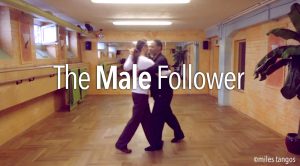At the beginning of our Tango lives, most of us who start out taking a weekly series to get our feet wet, just so that we can say we ‘learned’ to tango. If only that were the end of it. It’s not. The classes never stop really. If you want to improve. If you want to get better and better dances with better partners, then you need to improve. However, there’s a factor in that ‘improvement’ that’s never, ever discussed. And quite truthfully, it’s the game changer. It’s also the one that almost no one wants to do. They believe for a variety of reasons that X teacher will turn them into a desirable dancer, or that Y dancer’s feedback will magically create in them the amazing partner they’ve always wanted to be. If they just dance with X, or Y, or that if Z happened for them, that magically they’d become THAT dancer.
This is a fallacy and idle fantasy.
There is really only one thing that will create the dancer you want to be.
It’s not just classes. To be fair, classes only show you the basic constructs of how to do something. They’re not a catchall. They’re not meant to be a catchall either. They’re like the foundation of a house, and you need a good one that shows you all the tools that create a really good embrace (sans the tension, pressure, compression, and force), or a fabulous walk (sans the wobbling, wavering and foot lifting that happens so often).
It’s not just private study. Don’t mishear this as private study is not the end all be all. It can be a means to an end. The end being that you will clean up your issues that are integral to you and you alone. Not everyone’s private study experience will be the same, nor should it be. However private study, alone, by itself is not enough to create the right conditions to improve.
It’s not just solo practice. The reality is that solo practice can do wonders for you. Solo practice can give you a regime to follow. It can clean up your response times. It can create cleanliness in your executions and your technique. This is where drills happen, and repetition happens. Over and over again. However, by itself, Solo practice is not enough. You require a whole lot of something else that Solo Practice can’t give you.
It’s not just private practice. Yup. You do actually have to practice with a partner, and setting up private practice with a series (not just one) partner is absolutely crucial to your development as a better dancer. A few dances around the room to a few tandas and videoing yourself and then analyzing the video after each dance, nothing can replace that. However, it’s still not enough. It’s a good way to recognize your issues and to clean them up. But again…it’s not enough.
It’s not just social dancing. The fact is that social dancing can not be replaced. You actually have to go out social dancing on a regular basis to keep your skills at their peak. Social dancing keeps the tango muscle that you’ve developed in good working order, more than once per week is required. However, by itself, social dancing alone is not enough. There has to be something else.
The ‘D’ Word stands for Discipline.
All of those things above must be done, every day, every week, every month. Improvement comes not from doing one over the other. Nor does it come from some amazing teacher that gives you the magical tools that creates in you amazing dancing. Nor does it come from Classes, Private Study, Solo Practice, Private Practice, or Social Dancing. It comes from YOU.
You have to want to be better.
But first, you have to see that what you’re doing is less than desirable.
Without that want, without the realization that what you’re doing is less than desirable ? You’re spinning your wheels as it were.
And all of that requires Discipline. A dogmatic, pragmatic, dispassionate approach to the work that is divorced from the ‘emotional’ component that can and will cloud your development. Don’t mishear that as emotion is wrong or bad or less than desirable. It has it’s place to be certain. However, it should not be the end all be all of what you’re doing. It’s a valuable (cough, cough) component that some people rely on (solely). However the professional dancer does not rely on this, they use it as a tool for emphasis, but not the entire component of the dance. What do they rely on ? Discipline of technique, discipline of study, discipline of work, discipline….and lots of it. You want to be a better social dancer…the pathway towards better requires discipline.











